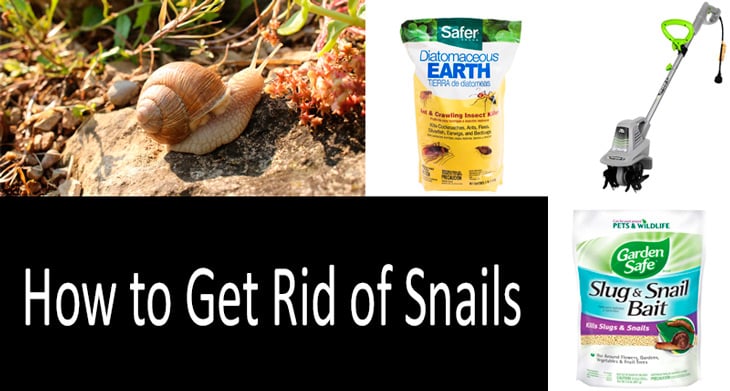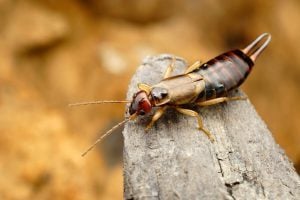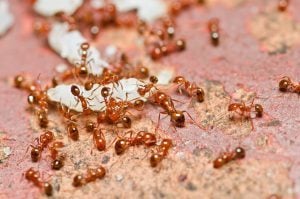How to get rid of snails? While being common garden pests, snails are hard to control because their populations recover pretty quickly after treatment. That is why you should take complex measures involving not only insecticide application but also trapping, creating barriers with copper tape or mesh, as well as tilling the soil and removing debris that could serve as a shelter for snails.
However, if you are short of time but want an immediate result, we recommend you using snail baits like the Garden Safe 4536 Slug & Snail Bait (HG-4536). The product contains a unique blend of iron phosphate and bait additives. Once digested, iron phosphate affects the insect’s ability to feed so that it eventually dies from starvation. While being highly effective against snails, iron phosphate is not toxic and can even be used around pets. The product is OMRI-listed and approved for application around flowers, vegetables, and fruits.
While being harmless, snails are nuisance pests because of slime trails they leave. Moreover, large populations of snails can damage your crops as they feed on plants, creating holes on foliage. That said, it is highly important to develop a balanced snail control strategy so that the treatment is effective yet safe for your garden. Put it differently, the cure should not be worse than the disease. Now, let’s elaborate on those options that are recommended by scientists and pest control experts.
#1. Modify Snail Habitat
The first thing you should do is to reveal and eliminate places where snails hide. Actually, if you fail to locate their shelters, you can resort to a trick. Make your own shelter for snails using an old flower pot or something like that. Put the pot upside down in the garden somewhere near plants where the snail damage was noticed. Place a small stone under one side of the pot so that it tilts a bit and snails could easily get in. Make sure that the soil under the improvised shelter is moist and cool. Wait until the mollusks congregate underneath it and then remove the pests.
Another important step to take is to till your garden. Not only will you get rid of all sorts of debris that can serve as a shelter for snails but you will also expose and kill snail eggs. In addition to tilling, you may cover the soil with gravel, like that by Exotic Pebbles, to impede their free movement.
As for a tiller, if you don’t already have one. You can speed up the whole process by using an electric device. A good example is the Earthwise TC70025 7.5-Inch 2.5-Amp Corded Electric Tiller. Rugged yet lightweight construction, powerful 2.5-Amp motor, ergonomic design, and low price — all this makes the Earthwise tiller an ideal choice for the average homeowner. The device tills up to 7.5 inches in width and 6 inches in depth. A soft grip is adjustable and comfortable to operate. On top of that, the unit is easy to use. Just push the power button, squeeze the lever, and that’s it! The only problem with this device is its cordless design as you will need to plug it in a power outlet and probably use an extension cord. But this inconvenience is offset by the greater power of corded models in comparison with battery-powered ones.
#2. Set Snail Traps
This is a targeted approach that works best for smaller gardens or as an auxiliary measure in controlling severe snail infestations. A good snail trap should be deep enough — at least one inch in depth — to prevent the mollusks from crawling out. Bury the trap in the ground and fill it with stale beer. Yes, snails like beer and this is a proven way to lure them into the trap. Once in the container, they will not be able to get out and will drown.
Entomologist Cheryl A. Wilen warns that beer attracts mollusks only within a radius of a few feet. Therefore for better results, you should set multiple traps at a distance of one to two feet. Do not forget to check and replenish the bait regularly, otherwise, beer will evaporate over time.
You may make such a trap yourself or purchase a ready-to-use one like the TruePower 40-4026 2 Pack Slug & Snail Safe. This product is cheap and designed specifically to catch mollusks. One set includes two 5 inch-diameter snail traps. Each container is 4 inches high, meaning you will be able to bury It deep enough while leaving no chances for snails to escape. Pour some beer or any other liquid based on yeast in the container, and cover the traps with the lids. The downside to this method is that the bait may attract some unwanted visitors. For example, one customer complains that the neighbor’s dog managed to remove the lids and drink the beer in the containers.
#3. Create Snail Barriers
You can use different materials to create barriers preventing snails from entering the protected area. The first option is copper tape, which is believed to be highly effective. By reacting with the snail’s slime, copper produces a kind of electric shock, something that will keep the mollusks away.
You may try the ELK Copper Foil Tape that can be wrapped around trees, flower beds, containers, and other surfaces. One ELK tape will protect up to 33 feet of area in your garden. When applying the tape, make sure there are no gaps left as snails may try to bypass your barrier. Another option is placing a copper mesh like the FLYBYE Garden Slug & Snail Copper Mesh. The advantage of this product is that it can be applied to the wet soil and can be laid around the entire perimeter. However, the latter may be counterproductive in case your snails have their shelters inside the protected perimeter.
Perhaps the most effective and popular material for creating barriers is diatomaceous earth. The major advantage of this option is its versatility. While being natural and safe, it works against a variety of pests and even kills some of them. Take a look at the Safer 51703 Diatomaceous Earth. For less than $10, you get four pounds of efficient dust repellent and insect killer that is widely used in pest control to deter unwanted bugs. Diatomaceous earth or D.E. is made of fossilized remains of diatoms, which are naturally occurring single-celled algae. The powder kills the insect either by means of sharp edges that cut open its exoskeleton or by dehydrating the insect upon digestion. The main issue with D.E. is that it is effective only when dry, which may be problematic outdoors.
#4. Use Natural Predators
Sometimes, it is wise to rely on nature. Biological control is the most environmentally friendly way to get rid of snails. All you need to do is to introduce predators feeding on these mollusks in your garden. These could be not only insects but also birds and fish. Turtles, chickens, geese, and even snakes will kill snails on a daily basis.
I suspect you are not fond of the idea of having snakes in your backyard, so you may try another option. According to scientists, over 100 species of nematodes are associated with snails. For example, the NaturesGoodGuys Live Beneficial Nematodes attack about 200 different insect species that live in the soil or in wood crevices. One pack contains as many as 15 million nematodes. What is particularly good about this product is that it includes 3 different species of nematodes so it’ll work for sure. When applied to the soil, they hunt out snails, penetrate them, and kill within several weeks. Yes, it is a slow-acting solution, but the benefit is that these guys do the whole job for you. Depending on the level of infestation, the product will treat up to 4,500 square feet.
#5. Place Snail Baits
Baits are generally available in granules and are easy to sprinkle in the ground. Apply snail baits to the soil near plants that attract these mollusks, but avoid sprinkling them on the plants themselves. If you have revealed their hiding places, distribute the bait there as well. To obtain better results, repeat the application several times. For safety reasons, do not place bait in piles as they may draw the attention of your pets or kids. Moreover, baits are more effective for these mollusks when distributed evenly.
When to apply snail baits? A major criterion here is snail activity. Snails come out after rainy days, favoring warm and humid weather. If the weather is too cold or too hot, baiting will not be effective enough because fewer mollusks will eat the stuff. As for the time of day, we recommend sprinkling bait in the evening when they are most active.
The most popular and reliable product on the market is the Garden Safe 4536 Slug & Snail Bait (HG-4536). Let’s start off with the fact that Garden Safe is a trusted brand of pest control products. Founded about two decades ago, Garden Safe offers fungicides, insecticides, and other products based on natural and organic ingredients. The Garden Safe 4536 contains a unique blend of iron phosphate and bait additives. Iron phosphate is not a toxic chemical but rather a compound that naturally occurs in the soil and is considered by the FDA as safe for humans. Once digested, iron phosphate affects the insect’s ability to feed so that it eventually dies from starvation. Generally, it takes about a week for the bait to kill the snail. The product is OMRI listed, i.e. qualified as organic, and can be safely applied around vegetables, fruit, and flowers.
#6. Apply Insecticides for Heavy Infestations
When dealing with severe infestations, you may use products containing chemical insecticides. There are two proven options. The first one includes spinosad, which is a chemical compound made by soil bacteria. This ingredient is generally safe and some insecticides based on spinosad are approved for organic gardening, according to the National Pesticide Information Center. This ingredient affects the snail’s/slug’s nervous system, causing paralysis. As a rule, the snail/slug dies within a couple of days after consuming or simply touching the substance.
You may want to consider the Monterey LG6570 Sluggo Plus Wildlife and Pet Safe Slug Killer. The solution is based on two highly effective ingredients — spinosad and iron phosphate. One pound of the insecticide can treat as many as 2,000 square feet. Besides, it has residue lasting for up to a month. While being powerful, it can be safely applied around ornamentals, vegetables, and fruits.
Another option is metaldehyde insecticide products. This compound is highly effective against snails and typically comes in the form of pellets. The reason why many manufacturers do not include it in their formulas is its high toxicity to pets. Therefore, I would recommend it only to those homeowners who do not have pets or keep them away from the garden. In this case, you may want to take a look at the Southern Ag Snail and Slug Bait. Its formula includes 3.25% metaldehyde and is very potent. One bag contains 20 pounds of pellets, with one pound of the insecticide covering up to 1,500 square feet.
Rules for Getting Rid of Snails: Science-Based Effectiveness
Experts from Clemson University warn that pesticides “should only be used as a last resort”. They say that while metaldehyde insecticides are allowed for application around fruits and vegetables, products containing iron phosphate are safer and a more recommended option.
Oregon State University scientists mention four pesticide ingredients that are the most effective against snails. These are methiocarb, iron phosphate, iron chelate, and metaldehyde. However, they note, even these products will not allow you to fully get rid of snails. The thing is that the best you can expect is the elimination of 70% of the snail population in your garden. And even worse, the population may recover in the long run if you do not take preventive measures like tilling the soil and removing debris. The experts also point to the importance of when and how much insecticide you apply as well as how many granules are put per square feet.
Utah State University scientists suggest planting snail-resistant plants as an effective way to control these mollusks. These are begonias, geraniums, nasturtiums, California poppies, and lantana. Snails will not be able to cause much damage to their foliage, so your garden will stay healthy and beautiful. Another option is choosing plants with a strong odor like lavender and rosemary.
Expert Opinion: Dave Hodgson, Professor of Ecology, University of Exeter
 Dave Hodgson, Professor of Ecology, University of Exeter
Dave Hodgson, Professor of Ecology, University of Exeter
Dave Hodgson is a Professor of Ecology and Head of the Bioscience Department at the University of Exeter, the UK. His areas of interest include ecological demography, biodiversity, parasites, statistical analysis in ecology. Dave teaches population ecology, evolution, ecological statistics, and has multiple scientific publications.
“I think we are not so aware of how much of the garden snails use. We think they are confined to the vegetable patch and this is what our research is designed to show. In fact, snails will explore similar patches to dogs and, therefore, come into contact with dogs during the day or at night. They will perhaps explore dog feces and toys in the garden. There are plenty of opportunities for dogs to meet with snails and possibly expose themselves to the parasites… The movement of snails is not something that many people think about apart from assuming that it is slow and not very significant. What we have been able to show is that it is relatively significant. A single snail can cover most of a British garden in one night. Dog owners need to be aware of where the snails are in their gardens. It isn’t entirely clear exactly how the parasite is contracted and transmitted between snails and dogs. But accidental ingestion is likely to be the main cause. From our results, we can see that snails take shelter during the day in crevices and nooks. Some of those nooks can be inside the dog toys.”












